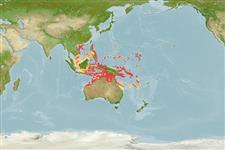>
Ovalentaria/misc (Various families in series Ovalentaria) >
Pomacentridae (Damselfishes) > Pomacentrinae
Etymology: Pomacentrus: Greek, poma, -atos = cover, operculum + Greek, kentron = sting (Ref. 45335).
Eponymy: Earl Desmond Reid (1885–1960) was Assistant Curator, Division of Fishes at the Smithsonian (United States National Museum, USNM) where Isaac Ginsburg also worked. [...] (Ref. 128868), visit book page.
More on authors: Fowler & Bean.
Environment: milieu / climate zone / depth range / distribution range
Ecologia
marinhas associadas(os) a recifes; não migratória; intervalo de profundidade 3 - 70 m (Ref. 9710). Tropical; 21°N - 25°S, 104°E - 171°E
Indo-Pacific: Philippines and Celebes to the Solomon Islands and Vanuatu, and the Great Barrier Reef; Palau in Micronesia (Ref. 7247). Reported from the Mentawai Islands, Indonesia.
Tamanho / Peso / Idade
Maturity: Lm ? range ? - ? cm
Max length : 9.0 cm TL macho/indeterminado; (Ref. 7247)
Descrição suscinta
Chaves de identificação | Morfologia | Morfometria
Espinhos dorsais (total) : 13; Raios dorsais (total) : 13 - 15; Espinhos anais: 2; Raios anais : 15 - 16.
Adults occur in steep outer reef slopes and deep lagoons to moderate depths. Generally solitary among large rubble pieces or the bases of large corals (Ref. 48636). Oviparous, distinct pairing during breeding (Ref. 205). Eggs are demersal and adhere to the substrate (Ref. 205). Males guard and aerate the eggs (Ref. 205). Diurnal species (Ref. 52881).
Ciclo de vida ou comportamento de acasalamento
Maturidade | Reprodução | Desova | Ovos | Fecundidade | Larvas
Oviparous, distinct pairing during breeding (Ref. 205). Eggs are demersal and adhere to the substrate (Ref. 205). Males guard and aerate the eggs (Ref. 205).
Allen, G.R., 1991. Damselfishes of the world. Mergus Publishers, Melle, Germany. 271 p. (Ref. 7247)
Status na Lista Vermelha da UICN (Ref. 130435: Version 2024-2)
Ameaça para os humanos
Harmless
Uso pelos humanos
Ferramentas
Relatórios especiais
Baixar XML
Fontes da internet
Estimates based on models
Preferred temperature (Ref.
123201): 26.2 - 28.9, mean 27.8 °C (based on 346 cells).
Índice de diversidade filogenética (Ref.
82804): PD
50 = 0.5000 [Uniqueness, from 0.5 = low to 2.0 = high].
Bayesian length-weight: a=0.02455 (0.01155 - 0.05216), b=2.98 (2.81 - 3.15), in cm total length, based on LWR estimates for this Genus-body shape (Ref.
93245).
Nível Trófico (Ref.
69278): 2.6 ±0.28 se; based on food items.
Resiliência (Ref.
120179): Elevada, tempo mínimo de duplicação da população menor que 15 meses (Preliminary K or Fecundity.).
Fishing Vulnerability (Ref.
59153): Low vulnerability (10 of 100).
Nutrients (Ref.
124155): Calcium = 125 [60, 190] mg/100g; Iron = 0.819 [0.497, 1.370] mg/100g; Protein = 18.1 [16.9, 19.2] %; Omega3 = 0.128 [0.075, 0.208] g/100g; Selenium = 29.5 [15.7, 55.2] μg/100g; VitaminA = 87.4 [22.8, 309.1] μg/100g; Zinc = 1.9 [1.3, 2.7] mg/100g (wet weight);
